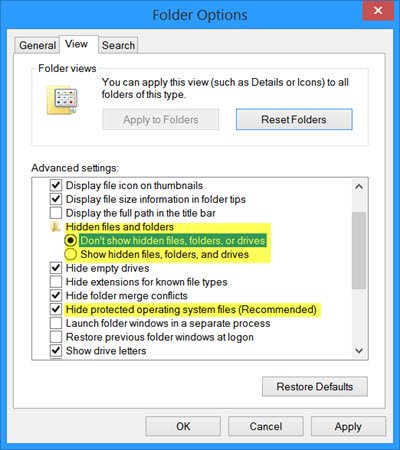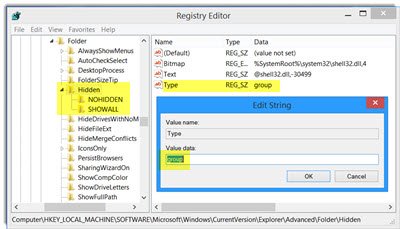We know that the Windows operating system contains some files and yet other system files and folders which are hidden by default. These are hidden so that the end-user does not by chance end up deleting or modifying their contents as they are required by the system to function properly. But there may be times, when you may need to show these hidden files and folders.
To show these hidden files and folders, type File Explorer Options in Windows 11/10 or Folder Options in Windows 8/7, in start search and hit Enter to open the window. Under the View tab, check the Hidden files, folders and drives check box. If you need to also show the system-protected hidden files and folders too, uncheck the Hide protected operating system files option.

Click Apply and exit. The hidden files and folders will now be visible.
Show hidden files and folders option missing
If you find that in your Windows, when you open your File Explorer Options earlier called Folder Options, via Windows Explorer > Organize > Folder & Search Option > Folder Options > View > Advanced Settings, the Show Hidden Files, Folders and Drives option is missing, then here is a Registry hack you can try, to enable it.
Create a system restore point first. Then type regedit in Windows start search box and hit Enter. Navigate to the following key:
HKEY_LOCAL_MACHINE\SOFTWARE\Microsoft\Windows\CurrentVersion\Explorer\Advanced\Folder\Hidden

In the right pane, right-click on Type and select Modify. Here Change Value Data to “group” without the inverted commas.
Click OK > Exit.
I hope this helps.
If this doesn’t help, then Windows 11/10/8.1 users may download and apply this registry fix. Alternatively, Windows 7, Windows Vista users could use our freeware FixWin to fix this issue. You will find the fix under its Explorer section.
At first, I was thinking to myself: “Who, who has ever used Windows before, doesn’t already know this?” But that was an arrogant thought, of course. I shouldn’t project onto others my knowledge of Windows.
I’ll tell you one thing about it that really *IS* useful, though, and that’s the registry fix. Er… I mean… don’t get me wrong, the first part — just the setting — is useful; but even the experienced users can benefit from the registry hack if the items are missing from the settings area…
…which brings me to a question: Is that a common problem in Win8? Something as basic as that setting simply not showing-up; and, therefore, needing a registry hack to fix it? Does Win8 (or some vendors pre-installing it on their machines) turn that off by default or something?
Just curious.
__________________________________
Gregg L. DesElms
Napa, California USA
gregg at greggdeselms dot com
Veritas nihil veretur nisi abscondi.
Veritas nimium altercando amittitur.
This problem occurs, in case (a) the registry settings has been somehow corrupted or (b) the computer is infected with malware, and the malware changes or blocks this setting to stay hidden from the human eye. This was a more frequent problem in the earlier versions on Windows, and may not be so common now. If this happens, then this is a way to fix it.
Yes, I’ve seen the folder options menu, itself, disappear because of malware. What I meant was that I’m not sure I’ve ever seen just those items from it disappear. In my experience, it’s the whole folder options settings dialog that malware sometimes makes disappear. That’s, in part, why fixing that particular problem is one of the things that tools like SuperAntiSpyware can do.
Interesting.
Thanks!
__________________________________
Gregg L. DesElms
Napa, California USA
gregg at greggdeselms dot com
Veritas nihil veretur nisi abscondi.
Veritas nimium altercando amittitur.
Some folders are still invisible. For example I could see c:windowssystem32driversetc only if I entered the complete path in the address bar.
I have found a solution which you can try and fix this issue as i too had this
go to : droidmonk.blogspot.in
please reply if it did not work for you. iam sure it would work.
You will be able to see all if you have allowed both, hidden files, folders and drives, as well as protected operating system files to be shown